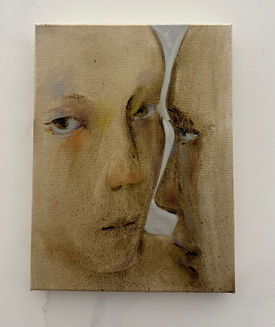
During my visit to George Rouy's exhibition "The Bleed, Part I" at Hauser & Wirth London, I encountered his monochromatic "phantom paintings" - massive canvases where silver pigment meets black charcoal. Standing barely a meter away from these life-sized works, I found myself immersed in a world of blurred boundaries and intertwined forms.
The scale of these works was overwhelming. At 270 x 240 cm, they dominated not just my field of vision but my entire sensory experience. The figures, larger than life, seemed to breathe and move, creating a dialogue that transcended mere visual observation. Those blurred, entangled limbs spoke of humanity's deepest conditions - our struggles, our interdependence, our collective consciousness.
In these intertwined forms, I saw metaphors for life itself - bodies struggling yet supporting, separating yet connecting. They reminded me of family relationships, where control and liberation dance in eternal tension. The elders' desire to control isn't malicious but a product of their own social conditioning; the younger generation's resistance isn't mere rebellion but a natural striving for independence. Like Rouy's figures, we are all both constraining and supporting each other, trapped yet sustained by our connections.


Inspired by this exhibition, I began creating a series of small oil paintings. This smaller format allows me to experiment and explore more freely, quickly capturing inspirations and trying different approaches. Through these works, I'm gradually developing my own visual language for expressing human relationships. While Rouy's impressive large-scale works have planted a seed of ambition for future larger pieces, I understand the importance of this current phase - using these smaller canvases to accumulate experience and mature both my ideas and techniques. It's a progressive journey: thoroughly exploring and experimenting on small canvases first, building a foundation for possible larger works in the future.
While I didn't adopt Rouy's "bleed" technique, his approach to abstracting human figures inspired me to explore my own way of depicting human relationships. In my work, I began to blur individual features, transforming figures into symbols - not of individual identity, but of collective experience. By removing specific details, these figures become universal, speaking to broader human experiences and connections.
Rouy's work demonstrates that art isn't just about what we see - it's about what we feel, what we recognize of ourselves in those undefined spaces between figures. Whether in his massive canvases or my smaller experiments, we're both exploring the same fundamental truth: human existence is never truly individual. We exist in a constant state of interaction, our boundaries both rigid and permeable, our identities both distinct and merged.
Key Words:
- Blurred Boundaries (模糊边界)
- Symbolic Representation (符号化表现)
- Collective Consciousness (集体意识)
- Intergenerational Relationships (代际关系)
- Human Connection (人际关系)
- Visual Dialogue (视觉对话)
- Artistic Scale (等身尺寸)
This journey through Rouy's exhibition has not only influenced my artistic practice but has deepened my understanding of how art can speak to the fundamental truths of human existence. It has shown me that sometimes, in the very act of blurring boundaries and details, we can reveal something esse